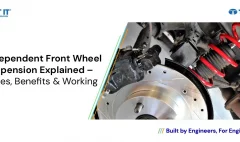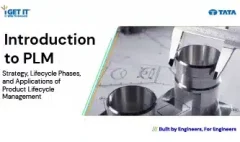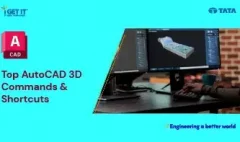Top 50 Design Engineer Interview Questions & Answers – [Updated]
May 28, 2024 2025-05-16 20:03Top 50 Design Engineer Interview Questions & Answers – [Updated]
Top 50 Design Engineer Interview Questions & Answers – [Updated]
My first mechanical design interview was a nerve-wracking experience. I spent weeks studying gear ratios, material properties, and every intricate detail of the design software. I waltzed through all the technical interview questions for design engineers, confidently explaining complex engineering concepts. But then, the interviewer hit me with a seemingly simple question: “Walk me through your design process.” My mind went blank. I stammered through a vague explanation, realizing I hadn’t properly articulated my thought process. That day, I learned a valuable lesson: technical knowledge is only half the battle. To succeed in the competitive world of mechanical design, you need to showcase both your technical expertise and your design thinking skills.
This blog is a result of countless hours spent researching and interviewing experienced designers, equips you with the knowledge and strategies to confidently answer any mechanical design engineer interview question, from the technical to the theoretical. We have made your preparation easy by categorizing the blog into two sections: Mechanical design engineer interview Q&A for freshers and for experienced professionals.
Table of Contents
Mechanical Design Engineers Interview Questions & Answers For Freshers
Now, let’s break the first hurdle! We’ll start with the essential building blocks: basic interview questions for mechanical design engineers. These questions might seem straightforward, but they offer a golden opportunity to showcase your core knowledge and design philosophy. They’re like the first impression you make – a chance to demonstrate your understanding of fundamental engineering principles and your ability to apply them in practical scenarios. Here is the list of design engineer interview questions and answers for freshers:
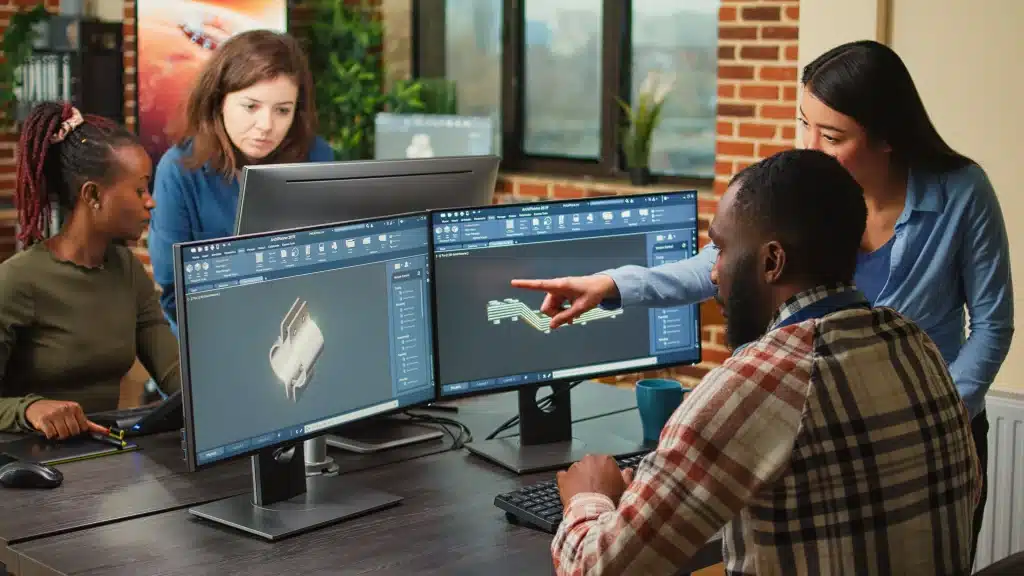
Question 1. What is mechanical design engineering?
Answer: Mechanical design engineering involves the creation and development of mechanical systems, components, and products. It encompasses various stages of the design process, from conceptualization and analysis to prototyping and testing, with the aim of producing innovative and functional solutions to engineering challenges.
Question 2. What are the key principles of mechanical design?
Answer: Key principles of mechanical design include understanding design requirements, adhering to industry standards and regulations, considering material selection, applying engineering principles like statics and dynamics, and ensuring manufacturability and reliability of designs.
Question 3. How does CAD software contribute to mechanical design engineering?
Answer: CAD software enables engineers to create detailed 3D models of mechanical components and systems, facilitating visualization, analysis, and simulation of designs. It streamlines the design process, allows for easy modification and iteration, and aids in communication with stakeholders.
Question 4. Explain the importance of geometric dimensioning and tolerancing (GD&T) in mechanical design.
Answer: GD&T is essential for communicating design specifications and ensuring the interchangeability and functionality of mechanical parts. It defines the allowable variations in dimensions, form, and orientation of features, leading to more precise and manufacturable designs.
Also read GD&T Interview Questions and Answers detailed blog
Question 5. What is finite element analysis (FEA), and how is it used in mechanical design?
Answer: FEA is a computational technique used to analyze the behaviour of complex structures under various loading conditions. It divides the structure into small elements to simulate its response to applied forces, allowing engineers to evaluate stress, deformation, and other performance metrics and optimize designs accordingly.
Question 6. Describe the role of material selection in mechanical design.
Answer: Material selection is crucial in mechanical design as it directly impacts the performance, durability, and cost of the final product. Engineers must consider factors such as mechanical properties, corrosion resistance, thermal conductivity, and cost when choosing materials for specific applications.
Question 7. What are the common manufacturing processes used in mechanical design?
Answer: Common manufacturing processes include machining, casting, forging, stamping, injection molding, and additive manufacturing (3D printing). Each process has its advantages and limitations, and the choice depends on factors such as part complexity, material properties, and production volume.
Question 8. How do you ensure a design is both functional and manufacturable?
Answer: To ensure a design is functional and manufacturable, engineers must consider factors such as part geometry, material properties, tolerances, assembly requirements, and manufacturing processes from the early stages of the design process. Prototyping, testing, and collaboration with manufacturing experts can help validate and optimize the design for production.
Question 9. What is design for assembly (DFA), and why is it important?
Answer: DFA is a methodology aimed at simplifying the assembly process and reducing production costs by designing products with ease of assembly in mind. It involves minimizing the number of parts, optimizing part orientation and placement, and standardizing fasteners and assembly techniques, ultimately improving efficiency and quality in manufacturing.
Question 10. Discuss the significance of innovation in mechanical design engineering.
Answer: Innovation drives progress in mechanical design engineering by enabling engineers to develop new technologies, improve existing products, and address emerging challenges. It fosters creativity, competitiveness, and the ability to deliver solutions that meet evolving customer needs and societal demands.
Question 11. What skills are essential for a career in mechanical design engineering?
Answer: Essential skills for a career in mechanical design engineering include proficiency in CAD software, strong analytical and problem-solving abilities, knowledge of engineering principles, effective communication and teamwork skills, attention to detail, and a willingness to learn and adapt to new technologies and methodologies.
Question 12. How do you approach problem-solving in mechanical design?
Answer: When approaching problem-solving in mechanical design, it’s important to define the problem clearly, gather relevant information, brainstorm potential solutions, analyze their feasibility and potential outcomes, and iteratively test and refine the chosen solution. Collaboration with colleagues and stakeholders can also provide valuable insights and perspectives.
Question 13. Can you explain the concept of tolerance stack-up in mechanical design?
Answer: Tolerance stack-up refers to the accumulation of dimensional variations in a mechanical assembly due to the tolerance of individual components. It can lead to deviations from the intended design specifications and affect the functionality and performance of the assembly. Managing tolerance stack-up involves careful consideration of tolerances, mating surfaces, and assembly sequences to ensure proper fit and function.
Question 14. What are some common challenges faced in mechanical design projects?
Answer: Common challenges in mechanical design projects include balancing conflicting design requirements, managing tight deadlines and budgets, overcoming technical constraints, ensuring regulatory compliance, addressing unforeseen issues during prototyping or testing, and effectively communicating with stakeholders.
Question 15. How do you stay updated with the latest trends and advancements in mechanical design engineering?
Answer: Staying updated with the latest trends and advancements in mechanical design engineering involves continuous learning through professional development activities such as attending conferences, workshops, and webinars, reading technical journals and publications, participating in online forums and communities, and networking with industry professionals.
Question 16. Describe a project where you utilized CAD software for design optimization.
Answer: In a project to optimize the design of a structural component, I used CAD software to create multiple design iterations with varying geometries and configurations. By performing simulations and analyses on each iteration, I identified the most efficient design in terms of weight, strength, and cost, leading to significant improvements in performance and manufacturability.
Question 17. What safety considerations are important in mechanical design engineering?
Answer: Safety considerations in mechanical design engineering include designing for proper ergonomics to prevent injury, ensuring adequate structural integrity to withstand loads and impacts, incorporating safety features such as guards and fail-safes, and complying with relevant safety standards and regulations.
Question 18. How do you ensure the sustainability of a design in mechanical engineering?
Answer: Ensuring the sustainability of a design in mechanical engineering involves considering factors such as material selection, energy efficiency, recyclability, and environmental impact throughout the design process. Incorporating principles of sustainable design and lifecycle assessment can help minimize resource consumption and environmental footprint.
Question 19. What is the role of documentation in mechanical design projects?
Answer: Documentation plays a crucial role in mechanical design projects by capturing design specifications, requirements, calculations, analyses, and revisions throughout the development process. It ensures consistency, traceability, and knowledge transfer among team members, stakeholders, and future users of the design.
Question 20. Explain the difference between static and dynamic analysis in structural engineering.
Answer: Static analysis evaluates the behavior of a structure under steady or slowly varying loads, focusing on factors such as stress, deformation, and stability. Dynamic analysis, on the other hand, considers the effects of time-varying or dynamic loads such as vibrations, impacts, and oscillations, providing insights into the structure’s response to dynamic events.
Mechanical Design Engineer Interview Questions & Answers For Experienced Professionals
Buckle up, seasoned engineers! This section tackles the advanced interview arena. We’ll explore interview questions designed to assess your in-depth knowledge, design optimization skills, and experience navigating complex projects. Here’s where you get to showcase your ability to think strategically, manage trade-offs, and lead design teams to success. Explore the list of advanced interview questions for design engineers.
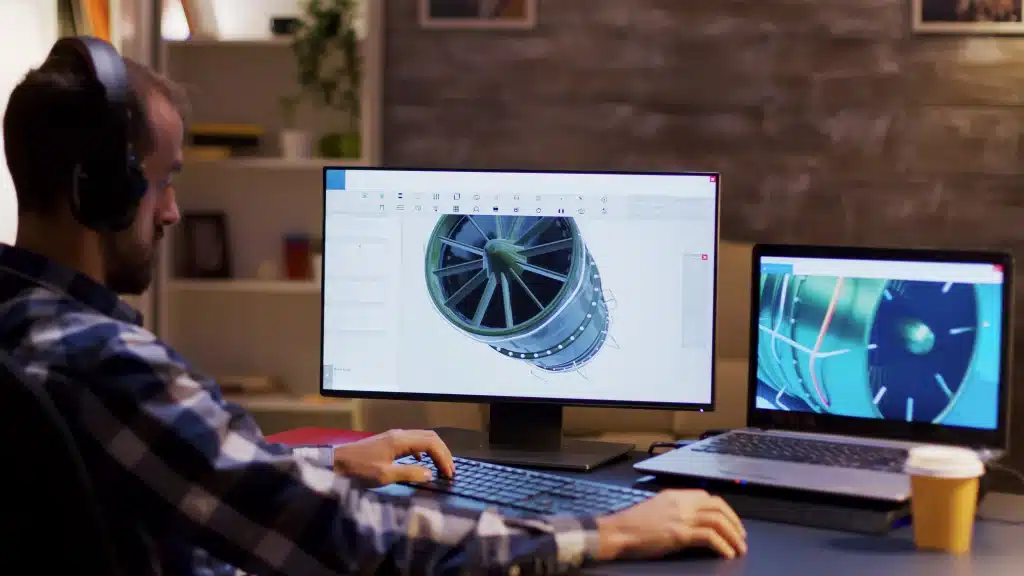
Question 1. How do you collaborate with other departments (e.g., manufacturing, quality assurance) in a design project?
Answer: Collaboration with other departments in a design project involves regular communication, sharing of information and requirements, and alignment of goals and priorities. This collaboration ensures that design decisions consider manufacturing capabilities, quality standards, and other considerations to achieve a successful outcome.
Question 2. Can you discuss a time when you had to revise a design based on feedback from stakeholders?
Answer: Yes, in a recent project, we received feedback from stakeholders regarding the usability of a product interface. We conducted user testing and gathered feedback to identify areas for improvement. Based on this feedback, we revised the design to enhance user experience, incorporating features such as intuitive navigation and clearer instructions.
Question 3. What factors do you consider when selecting materials for a design?
Answer: When selecting materials for a design, factors to consider include mechanical properties (e.g., strength, stiffness, toughness), thermal properties, corrosion resistance, cost, availability, manufacturability, environmental impact, and end-use requirements such as weight, durability, and aesthetics.
Question 4. How do you prioritize design requirements when faced with conflicting constraints?
Answer: Prioritizing design requirements involves understanding the project objectives, identifying conflicting constraints, evaluating their impact on key criteria such as functionality, cost, and schedule, and engaging stakeholders to make informed decisions. It may require trade-offs and compromises to achieve the best possible outcome within the given constraints.
Question 5. Describe a challenging problem you encountered in a design project and how you resolved it.
Answer: One challenging problem I encountered was optimizing the performance of a mechanical system while meeting stringent weight and cost constraints. I addressed this by conducting thorough analysis and simulation, exploring alternative designs, and collaborating with cross-functional teams to identify innovative solutions that balanced performance, weight, and cost effectively.
Question 6. What role does prototyping play in mechanical design?
Answer: Prototyping plays a crucial role in mechanical design by allowing engineers to validate and refine their designs before full-scale production. Prototypes provide valuable feedback on factors such as functionality, manufacturability, ergonomics, and performance, enabling engineers to make necessary adjustments and improvements early in the development process.
Question 7. How do you ensure the reliability of a design under varying operating conditions?
Answer: Ensuring the reliability of a design involves thorough analysis, testing, and validation under a range of operating conditions, including normal usage, extreme environments, and unexpected scenarios. Factors such as material selection, stress analysis, fatigue testing, and reliability modeling contribute to assessing and enhancing the design’s reliability.
Question 8. Can you explain the concept of tolerance analysis and its importance?
Answer: Tolerance analysis evaluates the cumulative effect of dimensional variations in a mechanical assembly on the overall functionality and performance. It helps identify potential issues such as interference, misalignment, or excessive clearances that may arise due to tolerance stack-up, allowing engineers to mitigate these issues and ensure proper fit and function.
Question 9. Describe a successful design project you worked on and its impact.
Answer: One successful design project I worked on involved developing a lightweight yet durable component for an automotive application. By optimizing the design using advanced materials and simulation techniques, we achieved significant weight reduction without compromising strength or performance, resulting in improved fuel efficiency and vehicle dynamics.
Question 10. How do you handle design changes or iterations throughout the development process?
Answer: Handling design changes or iterations involves maintaining clear documentation, tracking revisions, evaluating the impact on project scope, schedule, and budget, and communicating changes effectively with stakeholders. It requires flexibility, adaptability, and a systematic approach to managing revisions while ensuring alignment with project objectives.
Question 11. What software tools are commonly used in mechanical design engineering?
Answer: Commonly used software tools in mechanical design engineering include CAD software (such as SOLIDWORKS, Autodesk Inventor, and CATIA), simulation and analysis tools (such as ANSYS, Abaqus, and COMSOL), product lifecycle management (PLM) software, and computer-aided engineering (CAE) software for tasks like computational fluid dynamics (CFD) and finite element analysis (FEA).
Also read: CAD Interview Questions Handpicked by Experts blog
Question 12. How do you communicate design ideas effectively to team members and stakeholders?
Answer: Communicating design ideas effectively involves using visual aids such as sketches, diagrams, and 3D models, employing clear and concise language, tailoring the message to the audience’s level of understanding, soliciting feedback and actively listening to concerns, and fostering open dialogue and collaboration throughout the design process.
Question 13. Can you discuss the role of failure analysis in mechanical design?
Answer: Failure analysis is essential in mechanical design for identifying the root causes of component or system failures, understanding failure modes and mechanisms, and implementing preventive measures to mitigate future failures. It involves techniques such as root cause analysis, material testing, and failure mode and effects analysis (FMEA).
Question 14. What considerations are important when designing for mass production?
Answer: When designing for mass production, considerations such as manufacturability, scalability, cost-effectiveness, and quality control are crucial. Design features should facilitate efficient assembly, minimize material waste, optimize production cycle times, and ensure consistency and reliability in the manufactured products.
15. How do you balance cost and performance in design decision-making?
Answer: Balancing cost and performance involve evaluating trade-offs between different design options based on their impact on functionality, quality, manufacturability, and cost. It requires weighing the benefits of performance improvements against the associated increase in production costs to achieve an optimal balance that meets project requirements and budget constraints.
Question 16. Discuss the importance of ergonomics in product design.
Answer: Ergonomics plays a critical role in product design by focusing on optimizing the interaction between users and products to enhance comfort, safety, and usability. By considering factors such as anthropometric data, user preferences, and task requirements, ergonomic design aims to minimize user fatigue, prevent injuries, and improve overall user satisfaction and productivity.
Question 17. How do you address sustainability concerns in product design?
Answer: Addressing sustainability concerns in product design involves considering the environmental impact of materials, manufacturing processes, and product lifecycle stages. It includes using eco-friendly materials, designing for recyclability and energy efficiency, minimizing waste generation, and incorporating principles of circular economy and lifecycle assessment into the design process.
Question 18. Can you explain the concept of tolerance fit and its significance in mechanical engineering?
Answer: Tolerance fit refers to the intentional variation in dimensions between mating parts to achieve a desired level of interference or clearance. It ensures proper assembly and functionality while accommodating manufacturing variations and environmental conditions. Different types of fits (e.g., clearance fit, interference fit) are selected based on specific application requirements.
Question 19. Describe a time when you had to troubleshoot a design-related issue.
Answer: In a recent project, we encountered a vibration problem in a rotating machinery component. Through troubleshooting and analysis, we identified the root cause as an imbalance in the rotating assembly. We implemented corrective measures such as balancing procedures and structural modifications to mitigate the vibration and ensure the reliability of the design.
Question 20. What steps do you take to ensure regulatory compliance in mechanical design?
Answer: Ensuring regulatory compliance in mechanical design involves understanding relevant industry standards, regulations, and safety codes, conducting thorough risk assessments, integrating safety features and design controls, documenting compliance efforts, and collaborating with regulatory agencies and experts as needed to verify adherence to requirements.
Question 21. How do you approach risk assessment in mechanical design projects?
Answer: Risk assessment in mechanical design projects involves identifying potential hazards, assessing their likelihood and severity, and implementing measures to mitigate or eliminate risks. This may include incorporating safety features, conducting failure mode and effects analysis (FMEA), and establishing contingency plans to address unforeseen events.
Question 22. Can you discuss the role of testing and validation in the design process?
Answer: Testing and validation play a crucial role in the design process by verifying the performance, reliability, and safety of designs under real-world conditions. This may involve prototype testing, simulation, laboratory experiments, field trials, and certification testing to ensure that designs meet specified requirements and standards before production.
Question 23. Describe a time when you had to manage conflicting priorities in a design project.
Answer: In a complex design project, conflicting priorities may arise between meeting project deadlines, staying within budget constraints, and achieving design excellence. To manage these priorities, I prioritize tasks based on their criticality, allocate resources effectively, and communicate transparently with stakeholders to negotiate trade-offs and reach consensus on project objectives.
Question 24. What strategies do you use to optimize designs for cost efficiency?
Answer: Strategies for optimizing designs for cost efficiency include value engineering, material substitution, standardization of components, design simplification, reducing waste and complexity, and leveraging economies of scale through mass production or strategic sourcing. These strategies aim to minimize production costs while maintaining or enhancing product quality and performance.
Question 25. How do you ensure the manufacturability of a design?
Answer: Ensuring the manufacturability of a design involves collaborating closely with manufacturing engineers and suppliers, considering manufacturing capabilities and limitations early in the design process, designing for ease of fabrication and assembly, minimizing tooling and setup costs, and optimizing production processes to achieve efficient and cost-effective manufacturing.
Question 26. Discuss the importance of user feedback in product design.
Answer: User feedback is essential in product design for understanding user needs, preferences, and pain points, validating design concepts, identifying usability issues, and iteratively improving product functionality and user experience. Incorporating user feedback throughout the design process ensures that products meet user expectations and deliver value.
Question 27. What continuous improvement initiatives have you implemented in your design process?
Answer: Continuous improvement initiatives in the design process may include implementing lean principles to streamline workflows, conducting post-project reviews to identify lessons learned and best practices, implementing design automation tools to increase efficiency, and fostering a culture of innovation and knowledge sharing within the team.
Question 28. How do you handle tight deadlines in a design project?
Answer: Handling tight deadlines in a design project requires effective time management, prioritization of tasks, clear communication with stakeholders about project constraints and trade-offs, leveraging existing resources and expertise, and considering strategies such as phased delivery or incremental development to meet key milestones within the allotted timeframe.
Question 29. Can you discuss the role of simulation in mechanical design?
Answer: Simulation plays a critical role in mechanical design by allowing engineers to analyze and optimize designs virtually before physical prototyping or production. It enables engineers to evaluate performance, predict behavior under different operating conditions, identify potential issues, and iterate on designs to achieve optimal results efficiently.
Question 30. What advice would you give to aspiring mechanical design engineers?
Answer: My advice to aspiring mechanical design engineers is to continually expand your knowledge and skills through education, training, and hands-on experience, embrace challenges as opportunities for growth and learning, seek mentorship from experienced professionals, and stay curious, adaptable, and passionate about innovation and problem-solving in the field of mechanical engineering.
Following the exploration of the above Mechanical Design Engineer Interview questions, candidates will find themselves equipped with a deep understanding of the multifaceted nature of mechanical design engineering. These questions serve not only to assess one’s technical proficiency and problem-solving abilities but also as a compass guiding individual towards their dream job. By engaging with these questions, candidates gain valuable insights into the core principles, tools, and methodologies essential for success in the field. Moreover, the process of answering these questions fosters self-reflection, allowing candidates to recognize their strengths, identify areas for growth, and ultimately, envision themselves thriving in a role where their skills and passion converge to create meaningful impact.
Also read:Top 35 Electric Vehicle Engineer Interview Questions & Answers
How i GET IT Certification Courses Can Help You to Ace Interviews?
While interview preparation is crucial, remember that knowledge is power. Earning a design engineer certification course offered by i GET IT can significantly boost your competitive edge. Our comprehensive programs, developed by industry veterans, delve deeper into real-world applications of design principles, software proficiency, and industry standards. By tackling practical projects and simulations, you’ll solidify your understanding and gain the confidence to not only answer interview questions expertly but also excel in the demanding world of mechanical design. So, consider i GET IT by Tata Technologies design engineer certification course as your secret weapon – an investment that equips you with the knowledge and practical skills to not just ace interviews, but to thrive throughout your design engineering career.
Our platform’s extensive 2000+ range of courses, 8+ job role certifications and coverage of 20+ domain topics makes us a comprehensive hub for engineering education. By offering specialized certifications and personalized learning paths, we ensure that learners not only acquire knowledge but also develop expertise in their chosen fields.
Explore i GET IT today and embark on a journey towards professional excellence!
Vinay
Related Posts
What Is AutoCAD Software? Uses, Features & Practical Examples
Independent Front Wheel Suspension – Types, Benefits & Working
What is PLM? – Product Lifecycle Management [Detailed Guide]
Lead-Acid vs. Lithium-Ion Batteries: Key Differences & Best Uses
Top AutoCAD 3D Commands & Shortcuts with Examples
Find
Categories
Latest Posts
What Is AutoCAD Software? Uses, Features & Practical Examples
December 18, 2025Independent Front Wheel Suspension – Types, Benefits & Working
November 10, 2025What is PLM? – Product Lifecycle Management [Detailed Guide]
October 9, 2025Popular Tags






